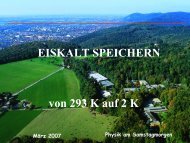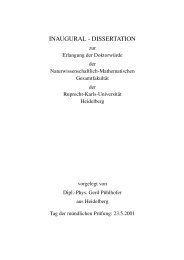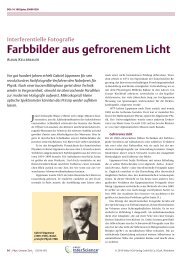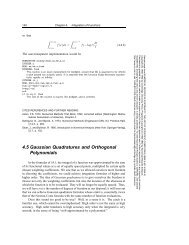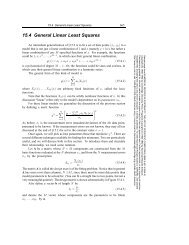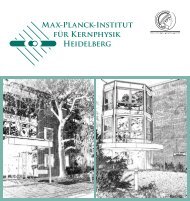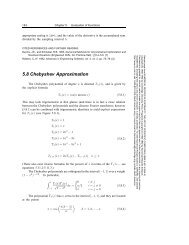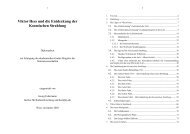TeV lightcurve of PSR B1259-63
TeV lightcurve of PSR B1259-63
TeV lightcurve of PSR B1259-63
You also want an ePaper? Increase the reach of your titles
YUMPU automatically turns print PDFs into web optimized ePapers that Google loves.
Universität<br />
<strong>TeV</strong> Flux modulation in<br />
<strong>PSR</strong> <strong>B1259</strong>−<strong>63</strong>/LS2883<br />
Matthias Kerschhaggl<br />
Physikalisches Institut<br />
Universitaet Bonn
● The system<br />
Contents<br />
● The <strong>lightcurve</strong><br />
● IC model<br />
● Results<br />
● Summary
● The system<br />
Contents<br />
● The <strong>lightcurve</strong><br />
● IC model<br />
● Results<br />
● Summary
The System <strong>PSR</strong> <strong>B1259</strong>-<strong>63</strong>/SS2883<br />
Orbit<br />
► Period 3.4 years<br />
● The system<br />
Contents<br />
● The <strong>lightcurve</strong><br />
● IC model<br />
● Results<br />
● Summary
<strong>TeV</strong> Lightcurve<br />
2004 HESS<br />
2007<br />
2004<br />
2007<br />
θ<br />
r
<strong>TeV</strong> Lightcurve Symmetry<br />
● <strong>TeV</strong> flux only a function <strong>of</strong> orbital separation r !?<br />
● Hints that <strong>PSR</strong> <strong>B1259</strong>-<strong>63</strong> is a periodical VHE emitter θ<br />
HESS<br />
2004<br />
2007<br />
r
X-rays vs. γ-rays<br />
● no symmetry w.r.t. periastron in X-rays<br />
pre<br />
post<br />
periastron<br />
● decrease in γ-ray flux at r ≈ 2e12 cm coincident<br />
with increase in X-rays<br />
θ<br />
r
X-rays vs. γ-rays<br />
● no symmetry w.r.t. periastron in X-rays<br />
● decrease in γ-ray flux at r ≈ 2e12 cm coincident<br />
with increase in X-rays<br />
θ<br />
r
X-rays vs. γ-rays<br />
● no symmetry w.r.t. periastron in X-rays<br />
● decrease in γ-ray flux at r ≈ 2e12 cm coincident<br />
with increase in X-rays<br />
θ<br />
r
● The system<br />
Contents<br />
● The <strong>lightcurve</strong><br />
● IC model<br />
● Results<br />
● Summary
Inverse Compton (IC) Cooling<br />
including non-radiative losses<br />
● Pure IC scenario does not describe<br />
the HESS data<br />
● Adiabatic losses and particle escape<br />
could play a key role in <strong>PSR</strong> <strong>B1259</strong>-<strong>63</strong><br />
● Analytical calculation <strong>of</strong> adiabatic<br />
losses non-trivial<br />
● Extract adiabatic cooling pr<strong>of</strong>ile from<br />
data by comparing with prediction<br />
adopting electron injection without non-radiative losses<br />
(Khangulyan et al., 2007)<br />
Electron distribution fkt EDF (Ginzburg & Syrovatskii 1964) :<br />
n e (t,γ) …EDF (per energy)<br />
γ dot … losses<br />
Q … e - injection spectrum<br />
E e max … e - cut<strong>of</strong>f energy<br />
A… norm; => fraction PW e - to<br />
injection e -
● The system<br />
Contents<br />
● The <strong>lightcurve</strong><br />
● IC model<br />
● Results<br />
● Summary
Cooling Pr<strong>of</strong>iles<br />
Tested three different cooling pr<strong>of</strong>iles γ dot ad to<br />
account for HESS data
Predictions<br />
2004/07 data qualitatively compatible with IC model<br />
including (phenomenologically) non-radiative losses.
Predictions<br />
Non monotonic cooling pr<strong>of</strong>ile γ dot ad (black) results in<br />
two additional dips at θ ± 75° (coincident with disc!)
X-rays<br />
● No quantitative agreement for X-ray data and (synchrotron) model<br />
prediction<br />
● Qualitative agreement for post-periastron (red) data<br />
● Magnetic field more complicated than simple B~1/r dependence adopted<br />
in model
Interpretation<br />
● If symmetry in <strong>TeV</strong> true →<br />
unexpected in leptonic scenario since IC is<br />
anisotropic<br />
● However, depends on many factors:<br />
production region size, γ-ray energy band,<br />
slope <strong>of</strong> e - -spectrum, T star , Doppler<br />
modulation etc.<br />
● If T' star = 1.5 x T star → IC occurs deeper in<br />
Klein-Nishina → more isotropic<br />
● Smoothing due to production region<br />
size?!<br />
● Compensation <strong>of</strong> effects (Doppler, γ-γ<br />
absorption, anisotropic IC)?!
● Decrease <strong>of</strong> <strong>TeV</strong> flux<br />
towards periastron<br />
around r~2e12 cm<br />
accompanied by increase<br />
in X-rays<br />
● Pulsar crosses disc →<br />
increase ram pressure →<br />
PW termination shock<br />
closer to pulsar → B-field<br />
enhancement<br />
● Behavior in X-rays not<br />
explained by this simple<br />
qualitative picture<br />
Interpretation II
● The system<br />
Contents<br />
● The <strong>lightcurve</strong><br />
● IC model<br />
● Results<br />
● Summary
Summary<br />
● <strong>TeV</strong> <strong>lightcurve</strong> <strong>of</strong> <strong>PSR</strong> <strong>B1259</strong> possibly symmetric<br />
● Can be described by leptonic IC scenario adopting<br />
non radiative losses.<br />
● Peculiar dips in the cooling pr<strong>of</strong>ile coincident with<br />
stellar disc position<br />
● “<strong>TeV</strong> Flux modulation in <strong>PSR</strong><strong>B1259</strong>−<strong>63</strong>/LS2883”,<br />
A&A 525, A80 (2011) [arxiv.org/abs/1009.5307]<br />
● Special thanks to: F. Aharonian, D. Khangulyan



